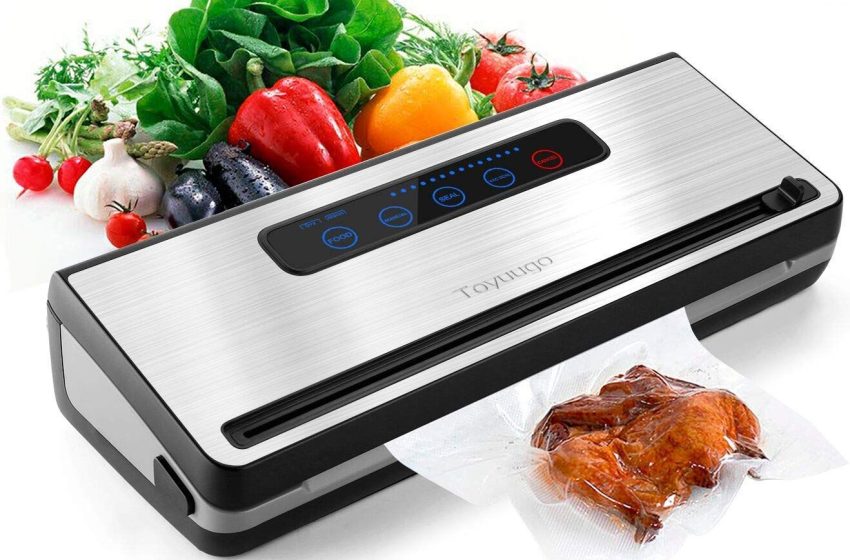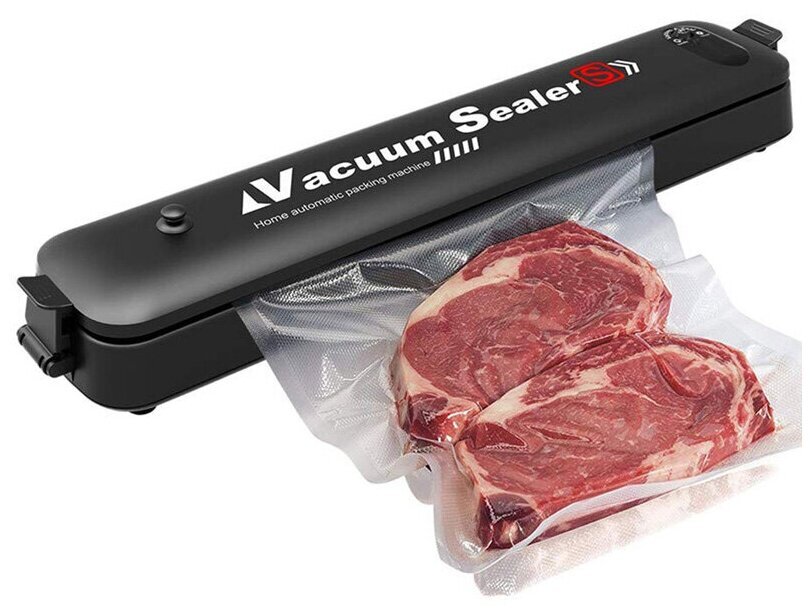Why You Need the Vacuum Sealers: The Vacuum Version

In food preservation and storage, sealers play a crucial role in maintaining freshness and prolonging shelf life. Among the various types of sealers available, vacuum sealers stand out for their ability to remove air from the packaging, creating an airtight seal that helps prevent food spoilage and freezer burn. In this blog post, we will explore the undeniable necessity of vacuum sealers and how they can revolutionize how you store and preserve your food.
Understanding the Basics of Vacuum Sealers
Getting started with a vacuum sealer is a straightforward process that involves a few but crucial steps to ensure the best results in preserving your food items. Initially, you’ll need to choose the right type of bag or container compatible with your vacuum sealer model. Most vacuum sealers work with specially designed bags that ensure a tight seal, but some models may also accommodate containers or jar attachments for even more versatility. Once you’ve selected the appropriate packaging, place your food items inside, leaving enough space at the open end for a proper seal.
Next, open the lid of the vacuum sealer and position the open end of the bag or container’s opening within the sealing area, ensuring it’s laid out flat to avoid wrinkles or folds that could compromise the vacuum seal. Close the lid and select the appropriate setting on your vacuum sealer—if your model offers different modes for dry or moist foods, choose the one that matches the contents of your bag.
As you activate the sealer, it will begin extracting air from the bag or container, visibly shrinking around the contents as it does so. Once the air has been fully evacuated, the machine will automatically seal the bag’s opening with heat, securing the airtight environment essential for extending the shelf life of your food. After the sealing process, remove the bag and ensure the seal is solid and uniform across the edge.
Remember, the success of vacuum sealing depends not only on the sealer itself but also on the quality of the bags or containers used and the proper preparation of food items before sealing. By following these basic steps, you can leverage the full potential of your vacuum sealer to maintain the freshness and quality of a wide variety of foods.
The Science behind Food Preservation
The science behind food preservation with vacuum sealers is rooted in the basic principles of microbiology and chemistry. When air, particularly oxygen, is present around food, it encourages the growth of aerobic bacteria and fungi, which are the primary culprits behind food spoilage and decay. These microorganisms need oxygen to thrive, and their growth can make food unsafe or simply unpalatable. Additionally, oxygen can cause fats in food to oxidize, leading to rancidity, and can affect the colour of fruits and vegetables, making them less appealing.
Vacuum sealers combat these issues by removing air from the packaging. This process creates an inhospitable environment for aerobic bacteria and fungi, significantly slowing their growth. Consequently, the shelf life of food is extended far beyond what traditional storage methods can offer. This is because, in the absence of oxygen, the chemical reactions that lead to food spoilage occur much slower.
Moreover, removing air also means reducing moisture inside the packaging. Moisture is another key factor that can lead to food spoilage, as it promotes mould and bacteria growth. By minimizing the air and, consequently, the moisture around food, vacuum sealers provide dual protection against common food spoilage agents.
It’s also important to understand that while vacuum sealing drastically slows down the deterioration of food, it does not halt it completely. Some bacteria, known as anaerobes, can grow without oxygen. However, the types of bacteria that are typically a concern in food preservation are significantly restricted by vacuum sealing, making it a powerful tool for extending the freshness and safety of food.
Innovative Uses of Best Vacuum Sealer beyond Food Preservation
Protecting Important Documents and Valuables
Beyond the kitchen, the Best Vacuum Sealer offers an excellent way to protect important documents, such as birth certificates, marriage licenses, and legal papers, from moisture, dust, and the ravages of time. By sealing these items in airtight bags, they are safeguarded against environmental damage, preserving their integrity and readability for years to come.
Efficient Clothing Storage
For those looking to maximize closet space or pack for travel, vacuum sealers can compress and protect clothing, bedding, and other textiles. This not only saves significant space but also protects items from water damage, pests, and odours, making it an ideal solution for seasonal clothing storage or keeping your luggage compact and organized
Outdoor and Camping Gear
Outdoor enthusiasts can use vacuum sealers to protect and compact their gear for camping trips, hiking, and other adventures. Sealed bags can keep matches dry, protect maps and electronics from moisture, and compress clothes or sleeping bags, making them easier to pack and carry.
Emergency Preparedness Kits
Building an emergency kit with vacuum-sealed components can ensure that food, medical supplies, and other critical items remain dry, sterile, and well-preserved. This is especially useful for items that need to be kept in long-term storage and ready for use in emergenciesemergencies.
Craft and Hobby Supplies
Vacuum sealers are a boon for craft enthusiasts, allowing them to protect and organize supplies like fabric, patterns, and beads. Sealing items prevents them from becoming damaged or lost and keeps them free from dust and moisture, ensuring they are in perfect condition when needed for a project.
The Environmental Impact of Vacuum-Sealed Packaging
Reduction in Food Waste
Vacuum-sealed packaging significantly reduces the amount of food wasted by extending the shelf life of perishables. Less food waste means more efficient use of resources and less discarded food ending up in landfills, where it contributes to methane emissions, a potent greenhouse gas.
Energy and Resource Efficiency
By preserving food for longer periods, vacuum-sealed packaging reduces the frequency of grocery shopping trips and the associated carbon footprint. It also means less reliance on energy-intensive cold storage in homes and commercial establishments, contributing to energy conservation.
Plastic Use and Recycling Challenges
One of the environmental drawbacks of vacuum sealing is the reliance on plastic bags and containers. While they offer numerous benefits for food preservation, producing and disposing plastic materials raise concerns about resource use and pollution. The recyclability of these materials is limited, prompting a need for more sustainable packaging alternatives.
Encouraging Bulk Buying
Vacuum sealers enable consumers to buy in bulk, which can reduce packaging waste from individually wrapped items and cut down on the carbon emissions associated with frequent trips to the store. When properly sealed and stored, bulk purchases maintain their quality over time and can diminish the environmental impact of packaging and transportation.
Promoting Sustainable Food Practices
Using vacuum sealers supports sustainable food practices by allowing for the preservation of seasonal produce and reducing the need for preservatives in food. By vacuum sealing and freezing seasonal fruits and vegetables, consumers can enjoy local produce year-round without the added carbon footprint of out-of-season, imported goods. This practice supports local agriculture and reduces dependency on global food supply chains, which often have a higher environmental cost.
Common Misconceptions about Vacuum Sealers Debunked
Only for Professional Kitchens
One common misconception is that vacuum sealers are designed exclusively for professional kitchens. This isn’t the case. The market offers various vacuum sealers suitable for home use, ranging from simple handheld models to more advanced automatic systems. They are user-friendly and can fit into any kitchen size or budget, making them accessible to home cooks who wish to extend the freshness of their food.
Complicated to Use
Another myth is that vacuum sealers are complicated and cumbersome to use. On the contrary, most models are straightforward, with clear instructions and sometimes one-touch operations. The vacuum sealing process involves just a few simple steps:
- Placing the food in the bag.
- Inserting the open end into the sealer.
- Pressing a button to evacuate the air and seal the bag.
Only for Long-Term Storage
While it’s true that vacuum sealers are excellent for long-term food storage, they are also incredibly useful for short-term needs. Vacuum-sealed leftovers can keep their freshness longer in the refrigerator, and vacuum-sealing can be a great way to prep and store ingredients for the upcoming week.
Limited to Certain Types of Food
Some believe vacuum sealers can only handle certain types of food. However, with the correct techniques, almost any type of food can be vacuum sealed. This includes solids, liquids, and semi-liquids once properly prepared (for example, by freezing liquids before sealing).
Expensive to Maintain
There’s a misconception that vacuum sealers are expensive to maintain, primarily due to the cost of bags. While specialty bags can have a higher upfront cost, the savings from reduced food waste and the ability to buy in bulk more than offset this expense. Additionally, many bags are reusable, further minimizing long-term costs.
Maximizing Storage Efficiency with Portable Vacuum Sealer
The beauty of Portable Vacuum Sealer goes beyond mere food preservation—it extends into organizational wizardry. The clutter and chaos often found in refrigerators, freezers, and pantries can be transformed into a well-ordered space by employing vacuum-sealed bags for storing food. These sleek and streamlined bags allow you to stack and store your food items in a way that maximizes every inch of available space.
Unlike traditional storage methods that can leave your freezer looking like a game of Tetris gone awry, vacuum-sealed bags lay flat or stack neatly, enabling you to easily see and access everything. This organization method saves space and reduces the time spent searching for ingredients, making meal preparation quicker and more efficient.
Additionally, using vacuum-sealed bags helps maintain a cleaner and more hygienic food storage environment. The airtight seal they provide prevents odours from mingling, ensuring that flavours remain true and foods stay fresher and longer. This sealing method is a barrier against cross-contamination, a common concern in shared storage spaces. When managing your kitchen, utilising vacuum-sealed bags for long-term storage and everyday use is a game-changer. They offer a flexible solution to keep your cooking space organized and your food items easily accessible, enhancing your overall culinary experience.
Conclusion
Vacuum sealers have emerged as indispensable allies in the kitchen, offering far more than just a means to store food. Their capability to extend the shelf life of foods by creating an oxygen-depleted environment enhances food preservation and contributes significantly to reducing food waste. This aligns with a growing awareness and effort to adopt more sustainable living practices. Beyond their primary application, these devices showcase remarkable versatility, proving beneficial in various scenarios, from protecting important documents to ensuring your clothes remain compact and fresh during travels.
FAQ’S
Q: What’s the process for vacuum sealing liquids?
A: To vacuum seal liquids, a useful trick is to freeze them first. Once solid, you can place them into a vacuum-seal bag without worrying about the liquid being sucked into the sealer. This method works well for soups, stews, and sauces.
Q: How much longer will food last if vacuum sealed?
A: Foods stored under vacuum seal can enjoy a significantly extended shelf life—up to 5 times longer than traditional storage methods. The exact duration depends on the type of food and storage conditions.
Q: Are vacuum-seal bags reusable?
A: Many types of vacuum-seal bags are designed for multiple uses. After use, they can be thoroughly washed with soap and water, completely dried, and reused. However, checking the manufacturer’s recommendations is important, as some bags might be single-use only.
|
Related Business Listings |


